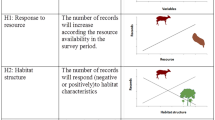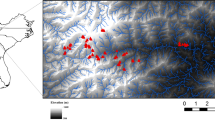Abstract
Many small terrestrial vertebrates exhibit limited spatial movement and are considerably exposed to changes in local environmental variables. Among such vertebrates, amphibians at present experience a dramatic decline due to their limited resilience to environmental change. Since the local survival and abundance of amphibians is intrinsically related to the availability of shelters, conservation plans need to take microhabitat requirements into account. In order to gain insight into the terrestrial ecology of the spectacled salamander Salamandrina perspicillata and to identify appropriate forest management strategies, we investigated the salamander’s seasonal variability in habitat use of trees as shelters in relation to tree features (size, buttresses, basal holes) and environmental variables in a beech forest in Italy. We used the occupancy approach to assess tree suitability on a non-conventional spatial scale. Our approach provides fine-grained parameters of microhabitat suitability and elucidates many aspects of the salamander’s terrestrial ecology. Occupancy changed with the annual life cycle and was higher in autumn than in spring, when females were found closer to the stream in the study area. Salamanders showed a seasonal pattern regarding the trees they occupied and a clear preference for trees with a larger diameter and more burrows. With respect to forest management, we suggest maintaining a suitable number of trees with a trunk diameter exceeding 30 cm. A practice of selective logging along the banks of streams could help maintain an adequate quantity of the appropriate microhabitat. Furthermore, in areas with a presence of salamanders, a good forest management plan requires leaving an adequate buffer zone around streams, which should be wider in autumn than in spring.




Similar content being viewed by others
References
Akaike H (1973) Information theory and an extension of the maximum likelihood principle. In: Petrov BN, Cazakil F (eds) Second international symposium information theory. Akademiai Kidao, Budapest, pp 267–281
Angelini C, Vanni S, Vignoli L (2007) Salamandrina terdigitata (Bonnaterre, 1789) Salamandrina perspicillata (Savi, 1821). In: Lanza B, Andreone F, Bologna MA et al (eds) Fauna d’Italia, vol XLII. Amphibia, Edizioni Calderini, Bologna, p 537
Anselmi R (1921) Sulla respirazione negli anfibi anuri ed urodeli con speciale riguardo alla Salamandrina perspicillata e allo Spelerpes fuscus. Note anatomofisiologiche Parte I Fisiologia Atti della Soc ligustica di Sci Nat e Geogr 4:107–129
Bailey LL, Simons TR, Pollock KH (2004) Spatial and temporal variation in detection probability of plethodon salamanders using the robust capture-recapture design. J Wildl Manag 68:14–24
Baldwin RF, Bell KP, Sanderson EW (2007) Spatial tools for conserving pool-breeding amphibians: an application of the landscape species approach. In: Calhoun AJK, DeMaynadier PG (eds) Science and conservation of vernal pools in northeastern North America. CRC Press, Boston, pp 281–297
Ball LC, Doherty PFJ, McDonald MW (2005) An occupancy modeling approach to evaluating a Palm Springs ground squirrel habitat model. J Wildl Manag 69:894–904. https://doi.org/10.2193/0022-541X(2005)069[0894:AOMATE]2.0.CO;2
Beale CM, Lennon JJ, Yearsley JM et al (2010) Regression analysis of spatial data. Ecol Lett 13:246–264. https://doi.org/10.1111/j.1461-0248.2009.01422.x
Bivand R, Piras G (2015) Comparing implementations of estimation methods for spatial econometrics. J Stat Softw 63:1–36
Bock M, Böhner J, Conrad O, et al (2011) SAGA. System for Automated Geoscientific Analyses
Bruni G, Romano A (2011) Courtship behaviour, mating season and male sexual interference in Salamandrina perspicillata (Savi, 1821). Amphibia-Reptilia 32:63–76. https://doi.org/10.1163/017353710X541878
Burnham KP, Anderson DR (2002) Model selection and multimodal inference, 2nd edn. Springer-Verlag, New York
Clauzel C, Bannwarth C, Foltete JC (2014) Integrating regional-scale connectivity in habitat restoration: an application for amphibian conservation in eastern France. J Nat Conserv 23:98–107. https://doi.org/10.1016/j.jnc.2014.07.001
Cliff AD, Ord JK (1981) Spatial process: models and applications. Taylor & Francis
Connette GM, Semlitsch RD (2013) Life history as a predictor of salamander recovery rate from timber harvest in Southern Appalachian Forests, U.S.A. Conserv Biol 27:1399–1409. https://doi.org/10.1111/cobi.12113
Costa A, Salvidio S, Posillico M et al (2015) Generalisation within specialization: inter-individual diet variation in the only specialized salamander in the world. Sci Rep 5:13260. https://doi.org/10.1038/srep13260
de Maynadier PG, Hunter MLJ (1995) The relationship between forest management and amphibian ecology: a review of the North American literature. Environ Rev 3:230–261. https://doi.org/10.1139/a95-012
Dorazio RM, Royle JA (2005) Estimating size and composition of biological communities by modeling the occurrence of species. J Am Stat Assoc 100:389–398. https://doi.org/10.1198/016214505000000015
Durso AM, Willson JD, Winne CT (2011) Needles in haystacks: estimating detection probability and occupancy of rare and cryptic snakes. Biol Conserv 144:1508–1515. https://doi.org/10.1016/j.biocon.2011.01.020
Faccio SD (2003) Postbreeding emigration and habitat use by Jefferson and spotted salamanders in Vermont. J Herpetol 37:479–489. https://doi.org/10.1670/155-02A
Fiske IJ, Chandler RB (2011) Unmarked: an R package for fitting hierarchical models of wildlife occurrence and abundance. J Stat Softw 43:1–23
Grialou JA, West SD, Wilkins RN (2000) The effects of forest clearcut and harvesting and thinning on terrestrial salamanders. J Wildl Manag 64:105–113
Griffiths RA, Foster J, Wilkinson JW, Sewell D (2015) Science, statistics and surveys: a herpetological perspective. J Appl Ecol. https://doi.org/10.1111/1365-2664.12463
Grover MC (2000) Determinants of salamander distributions along moisture gradients. Copeia 2000:156–168. https://doi.org/10.1643/0045-8511(2000)2000[0156:DOSDAM]2.0.CO;2
Higa M, Yamaura Y, Koizumi I et al (2014) Mapping large-scale bird distributions using occupancy models and citizen data with spatially biased sampling effort. Divers Distrib 21:46–54. https://doi.org/10.1111/ddi.12255
Hulme PE (2011) Practitioner’s perspectives: introducing a different voice in applied ecology. J Appl Ecol 48:1–2. https://doi.org/10.1111/j.1365-2664.2010.01938.x
Iknayan KJ, Tingley MW, Furnas BJ, Beissinger SR (2014) Detecting diversity: emerging methods to estimate species diversity. Trends Ecol Evol 29:97–106. https://doi.org/10.1016/j.tree.2013.10.012
Keen WH (1982) Habitat selection and interspecific competition in two species of plethodontid salamanders. Ecology 63:94–102
Keen WH (1984) Influence of moisture on the activity of a plethodontid salamander. Copeia 1984:684–688
Kéry M, Gardner B, Monnerat C (2010) Predicting species distributions from checklist data using site-occupancy models. J Biogeogr 37:1851–1862. https://doi.org/10.1111/j.1365-2699.2010.02345.x
Kraus D, Bütler R, Krumm F, et al (2016) Catalogue of tree microhabitats—reference field list. Integrate + Technical Paper
Lele SR, Merrill EH, Keim J, Boyce MS (2013) Selection, use, choice and occupancy: clarifying concepts in resource selection studies. J Anim Ecol 82:1183–1191. https://doi.org/10.1111/1365-2656.12141
Llorens P, Domingo F (2007) Rainfall partitioning by vegetation under Mediterranean conditions. A review of studies in Europe. J Hydrol 335:37–54. https://doi.org/10.1016/j.jhydrol.2006.10.032
MacKenzie DI, Bailey LL (2004) Assessing the fit of site-occupancy models. J Agric Biol Environ Stat 9:300–318. https://doi.org/10.1198/108571104X3361
MacKenzie DI, Nichols JD, Hines JE et al (2003) Estimating site occupancy, colonization, and local extinction when a species is detected imperfectly. Ecology 84:2200–2207
MacKenzie DI, Nichols JD, Royle JA, et al (2006) Occupancy estimation and modeling. Inffering patterns and dynamics of species occurrence. California, US
Mazerolle MJ (2015) Package “AICcmodavg”
Mcintyre AP, Jones JE, Lund EM, et al (2012) Empirical and simulation evaluations of an abundance estimator using unmarked individuals of cryptic forest-dwelling taxa. Forest Ecol Managem 286:129–136
Mihaljevic JR, Maxwell JB, Johnson PTJ (2015) Using multi-species occupancy models to improve the characterization and understanding of metacommunity structure. Ecology 96:1783–1792. https://doi.org/10.1007/s13398-014-0173-7.2
Mitchell NJ (2001) Males call more from wetter nests: effects of substrate water potential on reproductive behaviours of terrestrial toadlets. Proc R Soc B 268:87–93. https://doi.org/10.1098/rspb.2000.1334
Oatway ML, Morris DW (2007) Do animals select habitat at small or large scales? An experiment with meadow voles (Microtus pennsylvanicus). Can J Zool 85:479–487. https://doi.org/10.1139/Z07-023
Patrick DA, Hunter ML, Calhoun AJK (2006) Effects of experimental forestry treatments on a Maine amphibian community. For Ecol Manag 234:323–332. https://doi.org/10.1016/j.foreco.2006.07.015
Peterman WE, Semlitsch RD (2013) Fine-scale habitat associations of a terrestrial salamander: the role of environmental gradients and implications for population dynamics. PLoS One. https://doi.org/10.1371/journal.pone.0062184
Pinheiro J, Bates D, DebRoy S, et al (2015) Package “nlme”
Piraccini R, Cammarano M, Costa A, Basile M, Posillico M, Boitani L, Bascietto M, Matteucci G, De Cinti B, Romano A (2017) Habitat trees and salamanders: Conservation and management implications in temperate forests. For Ecol Manag 384:17-25
Pollock KH, Otto MC (1983) Robust estimation of population size in closed animal populations from capture-recapture experiments
Popescu VD, Hunter ML (2011) Clear-cutting affects habitat connectivity for a forest amphibian by decreasing permeability to juvenile movements. Ecol Appl 21:1283–1295. https://doi.org/10.1890/10-0658.1
Rittenhouse TAG, Semlitsch RD (2007) Distribution of amphibians in terrestrial habitat surrounding wetlands. WETLANDS 27:153–161. https://doi.org/10.1672/0277-5212(2007)27
Romano A, Bruni G, Paoletti C (2009) Sexual dimorphism in the Italian endemic species Salamandrina perspicillata (Savi, 1821) and testing of a field method for sexing salamanders. Amphibia-Reptilia 30:425–434. https://doi.org/10.1163/156853809788795128
Romano A, Costa A, Posillico M, Basile M (2016) Forest management and amphibians: focus on the genus Salamandrina. Ital J Agron 11:131–134
Romano A, Ficetola GF (2010) Ecogeographic variation of body size in the spectacled salamanders (Salamandrina): influence of genetic structure and local factors. J Biogeogr 37:2358–2370. https://doi.org/10.1111/j.1365-2699.2010.02369.x
Romano A, Ruggiero A (2008) Olfactory recognition of terrestrial shelters in females of Salamandrina perspicillata (Savi, 1821). Phyllomedusa 7:3–10
Salvidio S, Romano A, Oneto F et al (2012) Different season, different strategies: feeding ecology of two syntopic forest-dwelling salamanders. Acta Oecol 43:42–50. https://doi.org/10.1016/j.actao.2012.05.001
Semlitsch RD, Todd BD, Blomquist SM et al (2009) Effects of timber harvest on amphibian populations: understanding mechanisms from forest experiments. Bioscience 59:853–862. https://doi.org/10.1525/bio.2009.59.10.7
Stuart SN, Chanson JS, Cox NA et al (2004) Status and trends of amphibian declines and extinctions worldwide. Science 306(80):1783–1786
Suorsa P, Huhta E, Jäntti A et al (2005) Thresholds in selection of breeding habitat by the Eurasian treecreeper (Certhia familiaris). Biol Conserv 121:443–452. https://doi.org/10.1016/j.biocon.2004.05.014
Trombulak SC, Baldwin RF (2010) Landscape-scale conservation planning. Springer, New York
Utzeri C, Antonelli D, Angelini C (2004) A note on terrestrial activity and feeding in the Spectacled Salamander, Salamandrina terdigitata (Urodela, Salamandridae)
Vanni S (1980) Note sulla Salamandrina dagli occhiali [Salamandrina terdigitata (Lacépède, 1788)] in Toscana (Amphibia: Salamandridae). Atti Soc Toscana di Sci Nat ser. B 87:135–159
Vasconcelos D, Calhoun AJK (2004) Movement patterns of adult and juvenile Rana sylvatica (LeConte) and Ambystoma maculatum (Shaw) in three restored seasonal pools in Maine. J Herpetol 38:551–561. https://doi.org/10.1670/157-03A
Vitt LJ, Caldwell JP (2013) Herpetology. An introductory biology of amphibians and reptiles, 4th edn. Academic Press
Wells KD (2007) The ecology and behavior of amphibians. The University of Chicago Press, Chicago
Welsh HH (1990) Relictual amphibians and old-growth forests. Conserv Biol 4:309–319. https://doi.org/10.1111/j.1523-1739.1990.tb00293.x
Acknowledgements
This study was supported by the Life project, ManFor CBD LIFE09 ENV/IT/000078 (Managing Forests for multiple purposes: Carbon, Biodiversity and socio-economic well-being). All the experimental protocols were approved by the Italian Ministry of the Environment with the authorisation number PNM-II-2012-0015691. We are grateful to Rodolfo Bucci, Filippo La Civita, Rosario Balestrieri, Giovanni Capobianco, Salvatore Ferraro, Valeria Balestrieri, Riccardo Piraccini and Riccardo Novaga for their contributions to field sampling. Domenico De Vincenzi (Ufficio Territoriale per la Biodiversità di Isernia—Corpo Forestale dello Stato), and the staff at the Posto Fisso di Montedimezzo and Azienda Sperimentale Demaniale Torre di Feudozzo, contributed greatly by providing logistical facilities and accommodation close to the sampling site, as well as help and materials to carry out the sampling. Thanks are due to Martin Brimble and Mark Jonathan Walters for language revision. We would like to thank the two anonymous reviewers for their suggestions and comments.
Author information
Authors and Affiliations
Corresponding author
Ethics declarations
Conflict of interest
The authors declare that they have no conflict of interest.
Additional information
Communicated by: Sven Thatje
Rights and permissions
About this article
Cite this article
Basile, M., Romano, A., Costa, A. et al. Seasonality and microhabitat selection in a forest-dwelling salamander. Sci Nat 104, 80 (2017). https://doi.org/10.1007/s00114-017-1500-6
Received:
Revised:
Accepted:
Published:
DOI: https://doi.org/10.1007/s00114-017-1500-6




